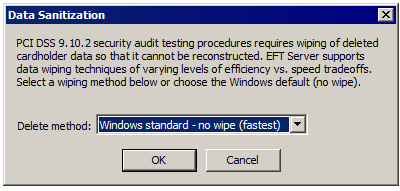Specifying File Deletion Options
The Regulatory Compliance Module (RCM) provides a data sanitization/data wiping option, which satisfies PCI DSS requirements. If you do not activate the module, this feature is disabled after the trial expires.
You can configure EFT to securely delete or purge a file by writing over the initial data using encrypted and/or pseudorandom data. A menu of purging methods is available; available options depend on the library used.
-
The 3-pass DoD method overwrites all addressable locations with a character and its complement, then a random character, and does this three times.
-
The pseudorandom data wiping method does the following:
-
Initializes the wincrypt library
-
Fills the file with randomly generated data from the wincrypt library
-
Flushes the data to disk
-
Deletes the file from file system calling the standard function DeleteFile()
*.pgp files are automatically excluded from the wipe process. When wipe is enabled, ANY delete operation also includes the wipe (sanitization) process.
To specify a delete method
-
In the administration interface, connect to EFT and click the Server tab.
-
On the Server tab, click the Site that you want to configure.
-
In the right pane, click the Security tab.
-
In the Data Security area, next to Secure data removal, click Configure. The Data Sanitation dialog box appears.

-
In the Delete method box, click the list to specify one of the following methods:
-
Windows standard (fastest)
-
Pseudorandom data (medium)
-
3-pass DoD 5220.22-m (slow)
-
-
Click OK to close the dialog box.
-
Click Apply to save the changes on EFT.
-
A message appears when the purging mechanism is changed to anything other than the Windows standard delete method.
For further reference regarding data wiping, see the following articles:
(These links are outside of Globalscape's domain and could change.)
-
Data remanence:http://en.wikipedia.org/wiki/Data_remanence,
specifically the section titled "Standard Patterns for Purging": http://en.wikipedia.org/wiki/Data_remanence#Standard_patterns_for_purging -
US DoD 5220.22-M Standard, defined in the US National Industrial Security Program Operating Manual of the US Department of Defense: http://en.wikipedia.org/wiki/National_Industrial_Security_Program
-
"Secure Deletion of Data from Magnetic and Solid-State Memory": http://www.usenix.org/publications/library/proceedings/sec96/full_papers/gutmann/